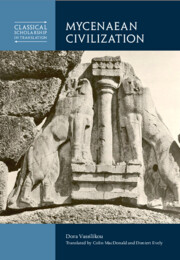Refine search
Actions for selected content:
210 results
10 - Mycenaean Greece in Homer
-
- Book:
- Mycenaean Civilization
- Published online:
- 19 December 2025
- Print publication:
- 15 January 2026, pp 566-579
-
- Chapter
- Export citation

Mycenaean Civilization
-
- Published online:
- 19 December 2025
- Print publication:
- 15 January 2026
CONSIDER THE NIGHTINGALE: CALLIMACHUS, EPIGR. 2 PF. = 34 G–P
-
- Journal:
- The Classical Quarterly , First View
- Published online by Cambridge University Press:
- 19 December 2025, pp. 1-4
-
- Article
-
- You have access
- Open access
- HTML
- Export citation
Chapter 11 - Prayer
- from Part II - Beliefs and Practices
-
-
- Book:
- Personal Religion in the Ancient Greek World
- Published online:
- 25 November 2025
- Print publication:
- 11 December 2025, pp 251-270
-
- Chapter
- Export citation
ANCIENT GREEK PERCEPTIONS OF DOVES
-
- Journal:
- The Classical Quarterly , First View
- Published online by Cambridge University Press:
- 03 December 2025, pp. 1-10
-
- Article
-
- You have access
- Open access
- HTML
- Export citation
1 - Debussy as Reader
- from Part I - Aesthetics
-
-
- Book:
- Debussy Studies 2
- Published online:
- 15 November 2025
- Print publication:
- 06 November 2025, pp 15-39
-
- Chapter
- Export citation
Chapter 2 - The Prologue of the Histories and the Greek Poetic Tradition
-
- Book:
- Herodotus and the Greek Poetic Tradition
- Published online:
- 04 November 2025
- Print publication:
- 06 November 2025, pp 36-56
-
- Chapter
- Export citation
Chapter 1 - Poetry in Herodotus, Herodotus on Poetry
-
- Book:
- Herodotus and the Greek Poetic Tradition
- Published online:
- 04 November 2025
- Print publication:
- 06 November 2025, pp 11-35
-
- Chapter
- Export citation
2 - Literary Form
- from Part I - First Principles: What Is a Gospel, According to Origen?
-
- Book:
- The Life of Jesus in the Writings of Origen of Alexandria
- Published online:
- 26 September 2025
- Print publication:
- 16 October 2025, pp 17-37
-
- Chapter
- Export citation
Curriculum uitarum: Homer and the many lives of Pythagoras and Empedocles
-
- Journal:
- The Journal of Hellenic Studies , First View
- Published online by Cambridge University Press:
- 26 August 2025, pp. 1-25
-
- Article
-
- You have access
- Open access
- HTML
- Export citation
4 - Potnia of the Labyrinth, Initiation of the King, and the Triple Sacrifice
-
- Book:
- Myth, Ritual, and Society in Mycenaean Anatolia
- Published online:
- 18 July 2025
- Print publication:
- 07 August 2025, pp 131-161
-
- Chapter
- Export citation
2 - Mycenaean and Vedic Sacrificial Posts
-
- Book:
- Myth, Ritual, and Society in Mycenaean Anatolia
- Published online:
- 18 July 2025
- Print publication:
- 07 August 2025, pp 47-66
-
- Chapter
- Export citation
6 - Nart Saga, Indo-Iranian Twins, and Dioscurias
-
- Book:
- Myth, Ritual, and Society in Mycenaean Anatolia
- Published online:
- 18 July 2025
- Print publication:
- 07 August 2025, pp 194-237
-
- Chapter
- Export citation
7 - Golden Fleeces
-
- Book:
- Myth, Ritual, and Society in Mycenaean Anatolia
- Published online:
- 18 July 2025
- Print publication:
- 07 August 2025, pp 238-272
-
- Chapter
- Export citation
5 - Mitannian and Anatolian Triads
-
- Book:
- Myth, Ritual, and Society in Mycenaean Anatolia
- Published online:
- 18 July 2025
- Print publication:
- 07 August 2025, pp 162-193
-
- Chapter
- Export citation
1 - A Mycenaean Ritual and Its Cult Language
-
- Book:
- Myth, Ritual, and Society in Mycenaean Anatolia
- Published online:
- 18 July 2025
- Print publication:
- 07 August 2025, pp 8-46
-
- Chapter
- Export citation
3 - Mycenaean Leaders in the Context of Indo-European and Indo-Iranian Society and Ritual
-
- Book:
- Myth, Ritual, and Society in Mycenaean Anatolia
- Published online:
- 18 July 2025
- Print publication:
- 07 August 2025, pp 67-130
-
- Chapter
- Export citation
Chapter 5 - Poetic Careers of Virgil Translators
-
- Book:
- Translating Virgil
- Published online:
- 15 May 2025
- Print publication:
- 05 June 2025, pp 355-398
-
- Chapter
- Export citation
AT LAST SPOKE DIOMEDES: DECORUM IN THE ILIADIC ASSEMBLY
-
- Journal:
- The Classical Quarterly , First View
- Published online by Cambridge University Press:
- 23 May 2025, pp. 1-12
-
- Article
-
- You have access
- Open access
- HTML
- Export citation
Chapter 8 - Ancient Poetry
- from Part II - Intellectual, Cultural, and Political Contexts
-
-
- Book:
- Percy Shelley in Context
- Published online:
- 17 April 2025
- Print publication:
- 24 April 2025, pp 59-66
-
- Chapter
- Export citation
